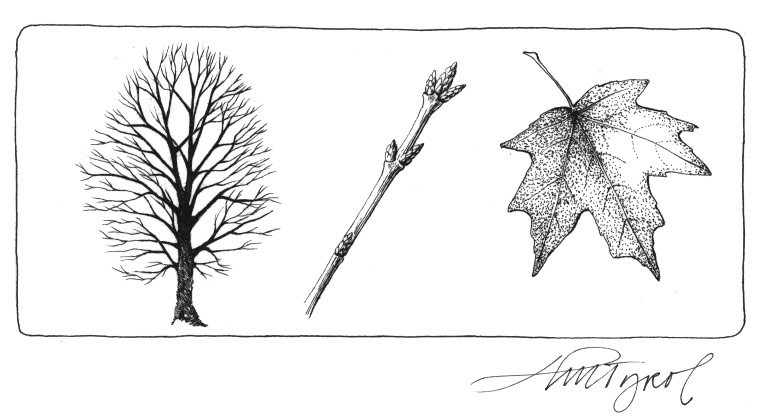
Thankfully, most northern trees aren’t dead in winter. They’re dormant – very much alive but relatively inactive. They still burn energy maintaining life, but little goes on in the way of growth. It’s just too cold. And water, being frozen, is unavailable. Dormancy is how trees avoid such unfavorable environmental conditions without moving to Florida.
The strategy makes sense. In most northeastern trees, the buds that burst open in spring were formed the previous summer. Inside these buds are the miniature beginnings of this coming year’s new shoots. They too were made last summer, but they spend the winter dormant and protected under bud scales until favorable growing conditions return in spring. And in what might well be the height of arboreal prudence, these dormant buds don’t even break during midwinter thaws. It’s a good thing, too, considering the alternative.
Imagine Joe Q. Sugar Maple dormantly waiting out November, December, and a nasty run of cold in early January. Then comes the thaw. You know the kind. It starts with some warm rain followed by spring-like breezes and temperatures above freezing for days. But if that sugar maple, impatient for spring, breaks bud and sends out those fleshy young shoots into the unseasonable warmth, its leaves could get zapped and blackened by the returning freeze. It’s a perfect way to lose the coming year’s growth, victimized by a cruel winter hoax. Happily, this rarely happens.
Trees avoid such midwinter mishaps not because they are programmed to simply wait a fixed time period until conditions are right. If that were the case, trees would break bud on the same spring day every year and, as we’ve all seen, the date of bud opening can vary by weeks from year to year. And clearly it’s not just warmth that stimulates budbreak, as January thaws demonstrate. Somehow, trees seem to “know” when true spring arrives and respond by breaking bud. Sure, some forest trees get nipped by late frosts, but generally they get it right.
It turns out the all-important environmental cue for spring budbreak is cold. That’s right, trees must first go through prolonged exposure to chilling temperatures (-5 C to 10 C) before subsequent exposure to warmth will force bud break. These environmental cues trigger physiological responses in trees, altering the balance of hormones and enzymes involved in promoting and inhibiting growth. Of course, the exact chilling temperatures and duration of exposure needed to break dormancy vary by species, individual, and geographic location. Some species need weeks of chilling, some need months. Though their actual dates of bud-break vary, you can count on trembling aspen every year, for example, to be among the first in New England to break bud and white ash to be among the last. Sugar maple tends to be in the middle, needing as many as 2,000 hours of exposure to low temperatures before it will flush. And whereas a red maple growing in the Upper Valley may require a few months of cold, the same species growing natively in Florida may require no cold at all.
Presumably, native trees growing on their natural sites have evolved a synchrony with the annual temperature cycles of their site. Everything’s just fine so long as trees are not planted out of their natural range and nobody messes with the temperature cycles. We’ve got the first part reasonably well in hand. Most nurseries, for example, pay close attention to frost hardiness and avoid stocking and selling southern source trees for planting in the north. The second part – messing with temperatures – is a bit more dicey.
Over generations, trees have proved adaptable to gradually changing environmental conditions. It’s when environments change rapidly that trees, like most of us, get into trouble. One alarming possibility about global climate change is its potential effect on the timing of dormancy in trees. If the pace of global warming exceeds a native tree’s ability to adapt, it may well lead to some very strange things happening in the woods. Some tree physiologists have suggested that certain trees might not receive enough chilling to break dormancy (much like sugar maples from Vermont that don’t break dormancy when grown in Georgia). Research continues, and although absolute predictions are few, there are suggestions that different tree species will respond differently to climatic warming and this could seriously alter their competitive abilities, their survival, and, eventually, their regional distribution. Happy spring.


Discussion *